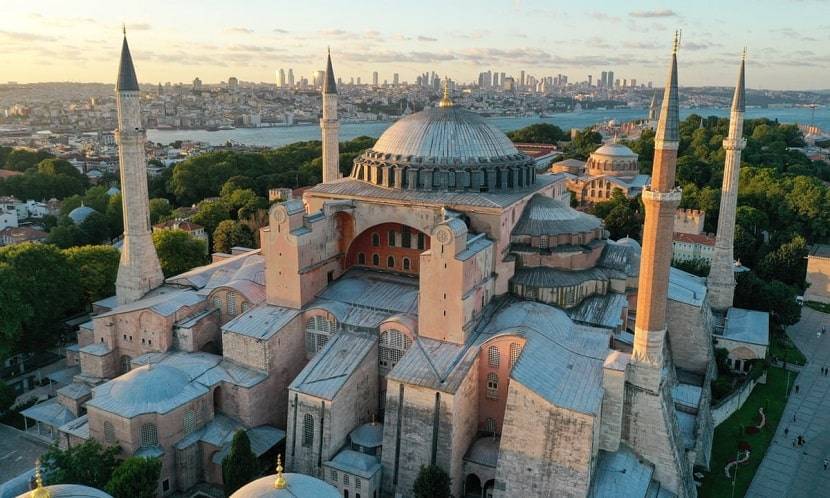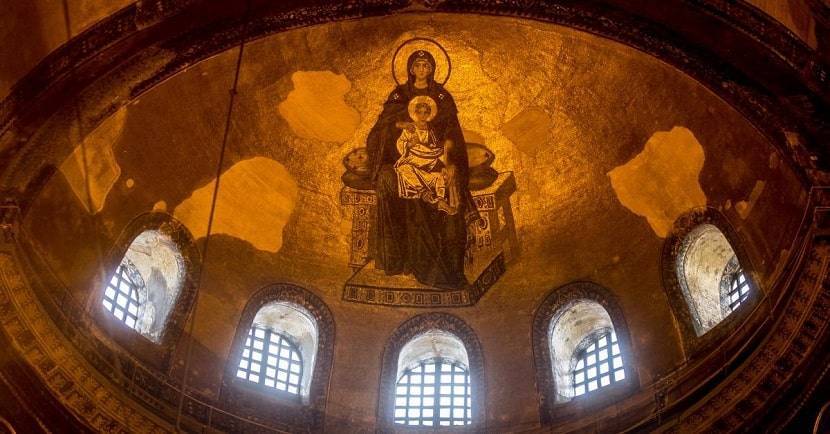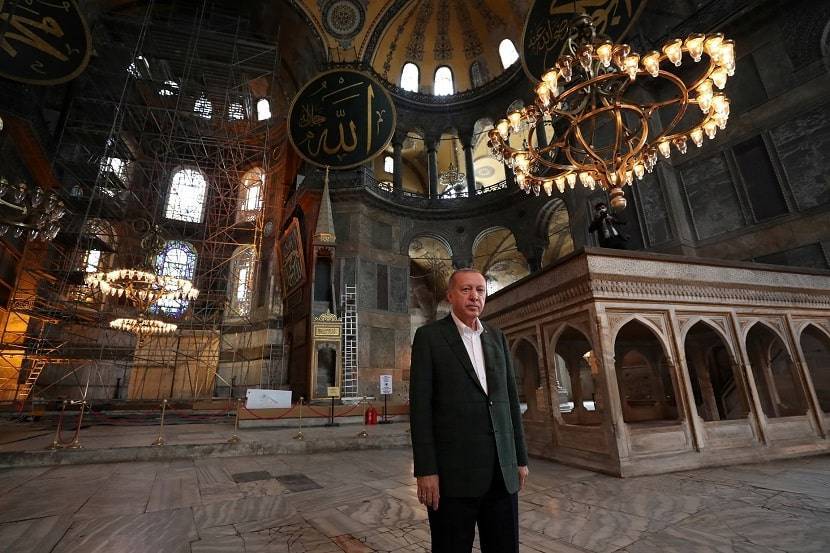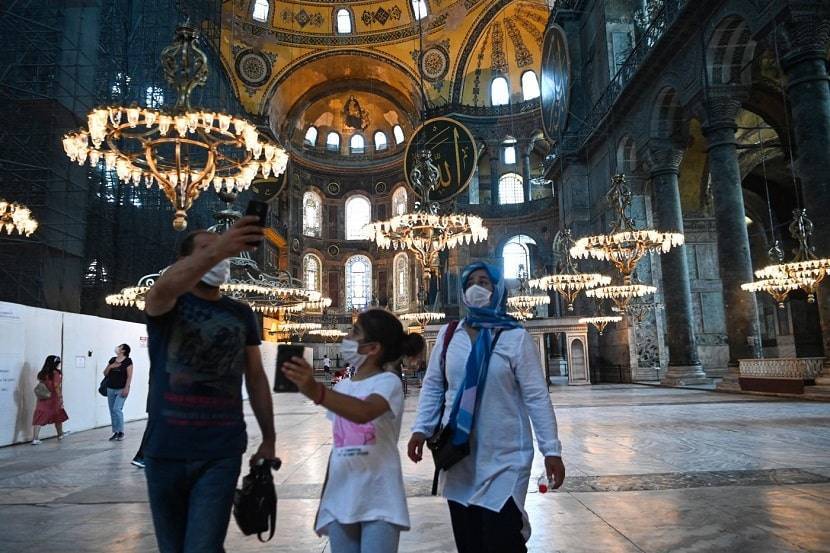Hagia Sophia, also known as the Church of the Holy Wisdom or the Church of the Divine Wisdom, is a significant Byzantine edifice in Istanbul and one of the world’s finest masterpieces. The Hagia Sophia (contemporarily a mosque) is known for both its appearance and inside. Outside the building, the mausoleums of Ottoman Sultans are among the first to be visited. Sultan Selim II, Sultan Murad III, Sultan Mehmed III, Sultan Mustafa I, and Sultan Ibrahim, whose reigns succeeded one another, have tombs and mausoleums. The Hagia Sophia Grand Mosque is more than a memorial to human endeavor and aesthetic expression.
It also serves as the final resting place for five sultans and their families, giving it a revered historical significance commensurate with its antiquity and history. The four minarets of Hagia Sophia, reported to have been erected by Mimar Sinan, the Sibyan (elementary) school fountain, the clock chamber, the fountains, buttresses, the treasury building, and the soup kitchen all add to the structure’s beauty.
History of Hagia Sophia
The Byzantine emperor Justinian I directed the construction of the church in the 6th century CE (532–537). It was a mosque, a museum, and then a mosque again over the years. The minarets and inscriptions of Islam, as well as the beautiful mosaics of Christianity, illustrate the religious transformations that have occurred in the region throughout the centuries.

The Hagia Sophia was finished in 537 CE after a remarkable six-year construction period. The names of the building’s architects—Anthemius of Tralles and Isidorus of Miletus—are well recognized, which is exceptional for the era in which it was erected, as is their competence with mechanics and mathematics. With a massive 32-meter (105-foot) main dome resting on pendentives and two semidomes on either side of the longitudinal axis, the Hagia Sophia blends a longitudinal basilica and a centred building in an entirely novel fashion. The structure is virtually square in plan. Three aisles are divided by columns, which have galleries above them and huge marble piers that support the dome. Windows puncture the walls above the galleries and the base of the dome, obscuring the supports in the glare of daylight and giving the appearance that the canopy floats on air.
Constantine I is claimed to have commanded the earliest church on the Hagia Sophia’s site to be built on the foundations of a pagan temple in 325. Constantius II, his son, consecrated it in 360. It was damaged in 404 by a fire that broke out during a riot following St. John Chrysostom’s second deportation as patriarch of Constantinople. Constans I, the Roman emperor, renovated and expanded it. Theodosius II rededicated the rebuilt structure in 415. The church was burned down again in January 532 during the Nika insurgency, giving Justinian I the chance to imagine a magnificent replacement.

♦ 10 Days Turkey Tour – Multi City
The current structure is largely a 6th-century construct, however a quake triggered a partial collapse of the dome in 558 (repaired 562) and two more partial collapses, after which it was reconstructed on a reduced scale and the entire church reinforced from the outside. In the mid-14th century, it was repaired once more. It was the Cathedral of the Ecumenical Patriarchate of Constantinople for almost a millennium. The Venetians and Crusaders sacked it in 1204 during the Fourth Crusade.
The building was secularized by Turkish President Kemal Atatürk in 1934, and it was turned into a museum in 1935. The building’s exquisite mosaics are considered by art historians to be the most important source of information on the status of mosaic work in the 8th and 9th centuries, just after the end of the Iconoclastic Controversy. The Hagia Sophia was named a component of the Historic Areas of Istanbul, a UNESCO World Heritage site that comprises the city’s other major historic buildings and locations, in 1985.
Once a Church, Later a Mosque
Mehmed II had it reconditioned as a mosque after the Turkish invasion of Constantinople in 1453, with the installation of a wooden minaret (on the exterior, a tower used for the summons to prayer), a large chandelier, a mihrab (niche denoting the direction of Mecca), and a minbar (pulpit). The crimson minaret on the southeast corner of the tower was built by him or his son Bayezid II. The original wooden minaret has been lost. Bayezid II built the mosque’s short white minaret on the northeast side. The two similar minarets on the western side were most likely ordered by Selim II or Murad III in the 1500s and erected by famed Ottoman architect Sinan.

In 2020, President Recep Tayyip Erdoan announced the contentious decision to repurpose the structure as a mosque. Soon after the declaration, Islamic prayers were offered, with the building’s Christian imagery partly hidden behind curtains. The Hagia Sophia, Turkey’s most popular tourist attraction, remained available to visitors.
The Etiquettes Non-Muslim Tourists to Adhere

The Hagia Sophia Mosque is open to all tourists, Muslims and non-Muslims alike. Before going upon the mosque’s rugs, visitors must take off their shoes. Avoid visiting the Hagia Sophia Mosque during prayer times (five times a day), particularly on Fridays at noon. When visiting the Hagia Sophia, women must cover their heads. Headscarves are available for free at the Hagia Sophia Mosque entrance. Photography is permitted; nevertheless, avoid taking photograph those who are praying in the mosque. During your visit, keep quiet, don’t run, and don’t stand in front of someone praying. The Hagia Sophia Mosque is free to see, however donations are appreciated.
♦ 5 Days Turkey Tour – Istanbul Antalya Tour
Hagia Sophia Visiting Information
Here are a few guiding points the visitors can take help from.
◊ Hagia Sophia Location
Sultan Ahmet, Ayasofya Meydanı No:1, 34122 Fatih/İstanbul, Turkey
◊ Entrance Fee
While visiting Hagia Sophia, there is no entrance fee.
◊ Hagia Sophia Visiting Hours
Hagia Sophia is open every day of the week, 24 hours a day. The best time to visit Hagia Sophia is from 9:00 a.m. to 12:00 p.m., which is the calm hour because it is a mosque and can get crowded during prayer times.

